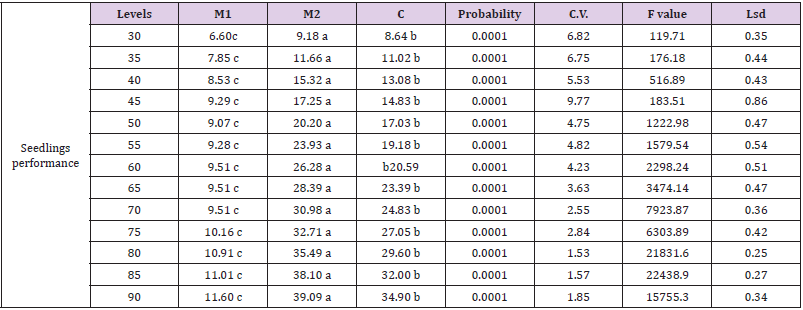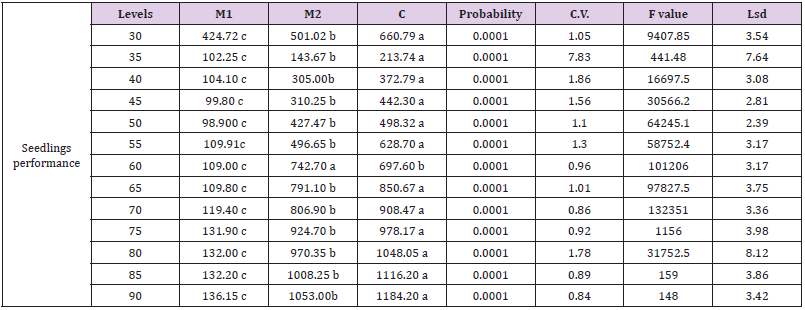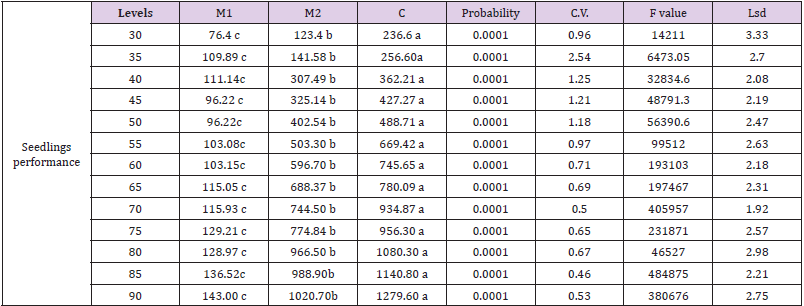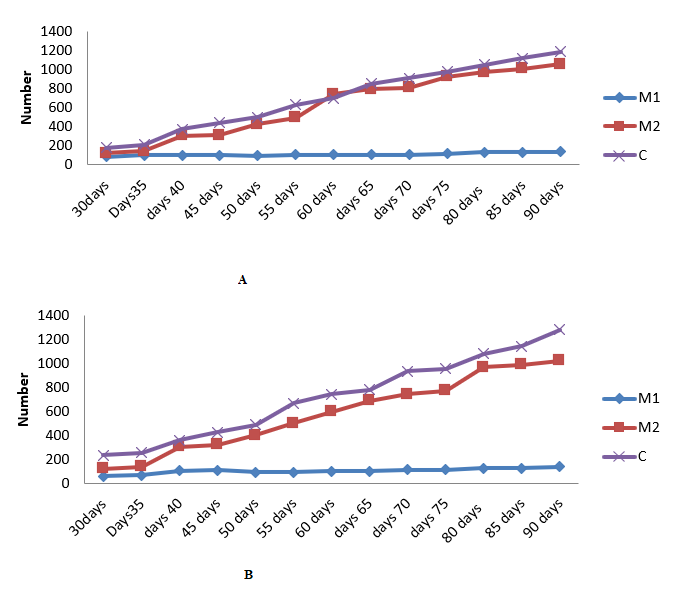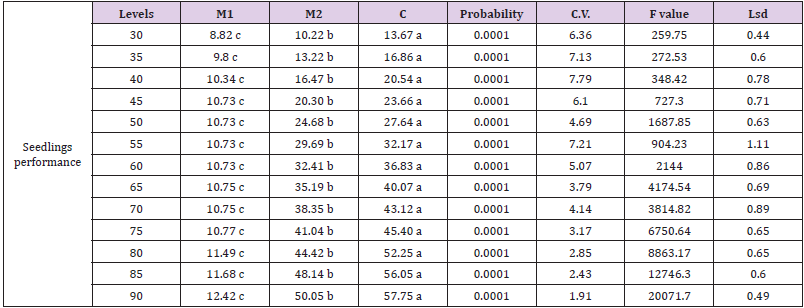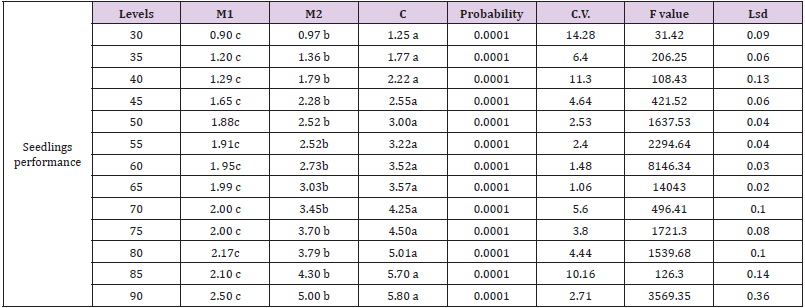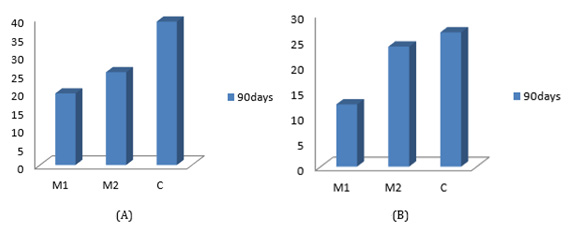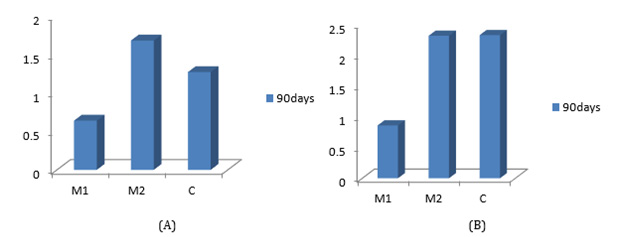ABSTRACT
Study was conducted in the nursery of Forest Department, Faculty of Forestry Sciences, University of Zalingei at Zalingei town, Central Darfur state, Sudan. Two experiments were carried out during the season 2018 and 2019. Five types of trees seeds were selected for this study and namely were: Acacia gerrardii, from shawa, Acacia sieberiana, from shawa, Acacia plyacantha from Aribo Valley, Acacia ataxtacantha from Jebel marra nursery scheme, Acacia seyal from shawa. Sixty plastic pots were arranged in a factorial design, with four replications, and Number of seedlings in any pots was twenty-five seedlings. First factor was types of media three types were used namely: silt was control (C), mixed (sawdust + clay soil +sand soil by ratio 1:1:1) (M1) and mixed (clay soil + sand soil + goats’ manure by ratio 1:1:1) (M2), other factor was Trees species. Space from experimental units to other 50 cm, the depth of sown 1cm. Irrigation: any plastic pot irrigated 1800ml before sowing, 300ml after sowing and 600 ml when it was necessary during the experiment period. Parameters were generally used, number leaves, number leaflets, seedlings length (cm), collar diameter (mm), roots length (cm) and shoots\ Root ratio. The data were subjected to analysis of variance by Statistical Analysis System (SAS) program and the Duncan’s Multiple Range Test was used to detect the significance of differences among the means. The media (C) and (M2) gave better similar results during two season in all parameters, number of leaves (32.29,34.90) , (30.94,39.09), leaflets (1184.20,1279.60 ),(1053.00 , 1020.70),seedlings length (47.36 cm, 57.75cm), (33.83cm, 50.05 cm), collar diameter (5.06 mm , 5.80 mm),(4.55mm, 5.00 mm ), root length (39.00 cm , 26.36 cm),(25.23 cm, 23.57 cm)and shoot \ root ratio (1.28, 2.33 ),(1.68, 2.32) respectively. but the media (M1) recorded less results in all parameters mentioned above during the two season in the experiment. The study recommended that the media M2 (mixed clay + sand + goats’ manure (ratio 1:1:1)), alternative media for sowing of Acacias trees seedlings when the media (silt) control was not available.
Keywords: Soil Media; Seedling; Acacia Trees; Nursery; Performance
Introduction
Acacias trees have various domestic uses in Sudan they contribute much to the national economy it is produce charcoal, Gam Arabic, woods and fodders for livestock, in addition to the multiple local uses of the Acacias, their timber is used for furniture, buildings, railway sleepers, agricultural equipment, and as firewood and Tannins from the leather industry products from the pods bark and leaves (Ahamed [1]). A forest tree nursery is an area of earth or plot designed and prepared to produce and to raise various kinds of forest tree seedlings for multipurpose uses by many methods (sexual and asexual propagation) (Keats, et al. [2,3]). Selecting the proper growing medium is one of the most important considerations in nursery plant production. A growing medium can be defined as a substance through which roots grow and extract water and nutrients. The selection of growing media is one of the most important decisions in the culture of seedlings. The physical, chemical and biological characteristics of the growing media affect seedlings growth and other aspects of nursery operations (Abdalla [3]). A good growing medium for the nursery is of vital importance as it promotes water absorption, nutrient availability and oxygen supply to the germinating seeds and seedlings. Growing media not only acts as a growing place but also as a source of nutrient for plant growth (Dayeswari, et al. [4]). Darfur’s natural resource base has been badly affected. Large-scale population displacement has resulted in environmental degradation, especially around camps and towns where natural vegetation is rapidly exhausted; environmental degradation is also an issue where pastoralists are gathered in large concentrations, causing overgrazing. Overcutting and overgrazing the main causes of degradation of trees cover in Zalingei area in the recent years because there are many people lose their livelihood resources because of displacement be Darfur conflict, this situation led numbers of people depending on trees to live. This study was conducted to test the best soil media for performance of some acacias trees seedlings growth namely Acacia seyal, Acacia gerrardii, Acacia sieberana, Acacia plyacantha and Acacia ataxtacantha, in the nursery.
Materials and Methods
This study was conducted in the nursery of Forest Department, Faculty of forestry Sciences, University of Zalingei at Zalingei town, Central Darfur state, Sudan. Zalingei area lies in western slopes of Jebel Marra. It covers about fifty square kilo meters in poor land savanna zone between latitude 12-30 and 13-30 north and longitudes 22-20 and 23 -45 east (Korssi, et al. [5,6]). Two a nursery experiment was carried out during the season 2018 and 2019, in Forest department nursery, Faculty of Forestry Sciences University of Zalingei. Five types of trees seeds were selected for this study and namely were: Acacia gerrardii, from shawa, Acacia sieberiana, from shawa, Acacia plyacantha from Aribo Valley, Acacia ataxtacantha from Jebel marra nursery scheme, Acacia seyal from shawa. Experiment was carried out during the periods from April to June 2018 and replicated at the same time in 2019. Sixty plastic pots were arranged in a factorial design, with four replications, and Number of seedlings in any pots was twenty-five seedlings. First factor was types of media three types were used namely: silt was control (C), mixed (sawdust + clay soil +sand soil by ratio 1:1:1) (M1) and mixed (clay soil + sand soil + goats’ manure by ratio 1:1:1) (M2), other factor was Trees species. Space from experimental units to other 50 cm, the depth of sown 1cm. Irrigation: any plastic pot irrigated 1800ml before sowing, 300ml after sowing and 600 ml when it was necessary during the experiment period. Measurements were taken after five days of sowing, and it was continuous every five days thought-out of experiment period (90 days) expect Roots length (cm) and Shoots\ Root length which taken at the last day of the experiment. Plant parameters measured in the plastic pots experiment were: -
a) Number leaves: For seedling growth leaves, three seedlings per replication were selected randomly
b) Number of leaflets: For seedling Number of leaflets, the same three seedlings per replication which selected randomly for seedling growth leaves were used.
c) Seedling length (cm): Seedling length was recorded in centimeter used a rubber for the same seedlings which mention above.
d) Diameter at Collar diameter (mm): Collar diameter of seedling was measured in millimeter (mm) by using small caliper for the same seedlings which used above.
e) Roots length (cm): for the same seedlings used a rubber to measuring root length.
f) Shoots\ Root length (cm): It was measured with a rubber. The data were subjected to analysis of variance by Statistical Analysis System (SAS) program and the Duncan’s Multiple Range Test was used to detect the significance of differences among the means.
Results and Discussion
Effect of Media on Number of Leaves During Two Season
Generally, there was high significant differences (P <0. 001) on number of leaves between the media silt as control (C), mixed goat manure +clay +sand (M2) collectively and media mixed sawdust +clay + sand(M1) throughout the experiment (90 days) in first season. Also, there was very high significant differences (P <0.0001) on number of leaves between the media (C), (M2) collectively and (M1) throughout the experiment (90 days). The results of effect of Medias similar for media (C), (M2) and (M1) during two seasons, the similarity returns to the same treatments used at the same conditions as shown in Table 1a and Figure 1A. in first season and Table 1b and Figure 1B. in second season. The effect of medias on performance of number of leaves, the media (C) and (M2) showed similarity on number of leaves during two seasons, the similarity refer to similar elements of minerals which favored by trees and media (M1) was poor than (C) and (M2) in the content of minerals which favored by trees.
Figure 1:
A) Effect of media on number of leaves first season 2018.
B) Effect of media on number of leaves in second season 2019.
Table 1a: Effect of media on number of leaves first season 2018.
Note: Values in the same rows having different letter are significantly different by Duncan Multiple Range test (DMRT) M1 ≡ mixed sawdust + clay +sand; M2 ≡ mixed clay + sand + goats’ manure; C≡ silt media control.
Table 1b: Effect of media on number of leaves in the second season 2019.
Note: Values in the same rows having different letter are significantly different by Duncan Multiple Range test (DMRT) M1 ≡ mixed sawdust + clay +sand; M2 ≡ mixed clay + sand + goat’s manure; C≡ silt media control.
Effect of Media on Number of Leaflets During Two Season
In general there was very high significant differences (P <0.0001) on number of leaflets between media silt control (C) and mixed goat manure +clay +sand (M2) respectively and mixed sawdust+ clay+ sand (M1) throughout the experiment (90 days) in first and second season. The results of effect of Medias on number of leaflets similar for media (C),(M2)and (M1)during two seasons, the similarity returns to resemble of the same treatments used at the same conditions as shown in Tables 2a & 2b and Figures 2A & 2B . The effect of medias on performance of leaflets, the media (C) and (M2) showed similarity on number of leaflets during two seasons, the similarity refer to similar elements of minerals which favored by trees and media (M1) was poor than (C) and (M2) in the content of minerals which favored by trees.
Table 2a: Effect of media on number of leaflets first season 2018.
Note: Values in the same rows having different letter are significantly different by Duncan Multiple Range test (DMRT) M1 ≡ mixed sawdust + clay +sand; M2 ≡ mixed clay + sand + goats manure;C≡ silt media control.
Table 2b: Effect of media on number of leaflets second season 2019.
Note: Values in the same rows having different letter are significantly different by Duncan Multiple Range test (DMRT)M1 ≡ mixed sawdust + clay +sand; M2 ≡ mixed clay + sand + goat’s manure; C≡ silt media control.
Figure 2:
A) Effect of media on number of leaflets first season 2018.
B) Effect of media on number of leaflets second season 2019.
Effect of Media on Seedling Length During Two Season
In general, there was very high significant differences (P <0.0001) on seedlings length between the media silt control (C), mixed goat manure +clay+ sand (M2) respectively and mixed sawdust+ clay+ sand (M1) throughout the experiment (90y days) in first and second season. The results of effect of Medias on seedling length similar for (C), (M2) and (M1) during two seasons, the similarity returns to resemble of the same treatments used at the same conditions as shown in Tables 3a & 3b and Figures 3A & 3B. The effect of medias on performance of seedlings growth, the media (C) and (M2) showed similarity on seedlings length during two seasons, the similarity refer to similar elements of minerals which favored by trees, media (M1) was poor than (C) and (M2) in the content of minerals which favored by trees. Daldoum and Hakim [7] recorded that the media silt + zero compost obtained (63cm), media silt+ 25% compost gave (74.), the media silt + 50% compost stated (76.0 cm) and the media silt+ 75% compost recorded (77.3cm) in shoot length of Acacia seyal. which, among these results of medias the media silt+ 75% compost observed better results (77.3cm) in shoot length growth after twelve month. These results agree with the results which obtained higher seedlings length in the experiments in media (C) and media (M2). These results agree with Ball et al (2013) were recorded that the goat manure gave the best result(39.5 cm) for the Terminalia bellirica also, agree with Ahmadloo, et al. [8] were indicated that the treatments (control soil cattle manure)obtained better results on shoot length (31.51cm) for the both species (Cupressus arizonica,Cypress sempervirens). while, when goat manure gave 48.14cm of Okra plant after eight weeks of planting which mentioned by Sanni, and Adenubi [9], that result similar with those obtained in media (M2) in the experiment, in spite of, differences in species.
Figure 3:
A) Effect of media on seedling length first season 2018.
B) Effect of media on seedling length second season 2019.
Table 3a: Correlation between family suffering of participants and academic performance of medical laboratory students.
Note: Values in the same rows having different letter are significantly different by Duncan Multiple Range test (DMRT) M1 ≡ mixed sawdust + clay +sand; M2 ≡ mixed clay + sand + goat’s manure; C≡ silt media control.
Table 3b: Effect of media on seedling length in the second season 2019.
Note: Values in the same rows having different letter are significantly different by Duncan Multiple Range test (DMRT) M1 ≡ mixed sawdust + clay +sand; M2 ≡ mixed clay + sand + goat’s manure; C≡ silt media control.
Effect of Media on Collar Diameter During Two Season
Generally, there was very high significant differences (P <0.0001) on collar diameter between the media silt control (C), mixed goat manure + sand + clay (M2) respectively and mixed sawdust + clay + sand (M1) throughout the experiment (ninety days) in first and second season. The results of effect of Medias on collar diameter similar for media (C), (M2) and (M1) during two seasons, the similarity returns to resemble of the same treatments used at the same conditions as shown in Tables 4a & 4b and Figures 4A & 4B. The effect of medias on performance of on collar diameter, the media (C) and (M2) showed similarity on collar diameter during two seasons, the similarity refer to similar elements of minerals which favored by trees, media (M1) was poor than (C) and (M2) in the content of minerals which favored by trees. Ball, et al. [10] reported that the media silt loam obtained high collar diameter 7.1mm of 1year old seedlings of Terminalia bellirica, also Mathowa, et al. [11] indicated that the media top garden soil (silt) obtained high collar diameter (4.22mm) of Adansonia digitata during twelve weeks, that result similar with those gave on media (C).while, Ahmadloo, et al.[8] were indicated that the treatments (control soil cattle manure) obtained better results on collar diameter (4.82cm) of both species(Cupressus arizonica Arizonica grmeene) and medite cypress (Cypress sempervirens) this results resemble with those obtained in media (C),(M2).
Figure 4:
A) Effect of media on collar diameter in first season 2018.
B) Effect of media on collar diameter in second season 2019.
Table 4a: Effect of media on collar diameter in first season 2018.
Note: Values in the same rows having different letter are significantly different by Duncan Multiple Range test (DMRT) M1 ≡ mixed sawdust + clay +sand; M2 ≡ mixed clay + sand + goats manure; C≡ silt media control
Table 4b: Effect of media on collar diameter in second season2019.
Note: Values in the same rows having different letter are significantly different by Duncan Multiple Range test (DMRT) M1 ≡ mixed sawdust + clay +sand; M2 ≡ mixed clay + sand + goat’s manure; C≡ silt media control
Effect of Media on Root Length During Two Season
Generally, There was very high significant differences (P <0.0001) on root length between media silt control (C), mixed goat manure +clay+ sand (M2) and mixed sawdust +clay+ sand (M1) respectively in the last day of experiment (90 days) in first and second season. The results of effect of Medias on root length similar for media (C),(M2)and(M1)during two seasons, the similarity returns to resemble of the same treatments used at the same conditions as shown in Table 5 and Figures 5A & 5B.The effect of medias on performance of root length, the media (C) and (M2) showed similarity on root length during two season, the similarity refer to similar elements of minerals which favored by trees, media (M1) was poor than (C) and (M2) in the content of minerals which favored by trees. Daldoum and Hakim [7] recorded that the media silt + zero compost obtained (28.5cm) media silt + 25% compost gave (34.8cm.), the media silt + 50% compost stated (21.5 cm) and the media silt+ 75% compost recorded (26.3 cm) on root length of Acacia seyal, which among these results of medias the media silt + 25% compost observed better results (34.8cm) in root length growth after twelve month. Those results agree with the results which obtained higher root length in the experiments in media (C) and media (M2). While Ahmadloo, et al. [8] were indicated that the treatments (control soil cattle: manure) obtained better results on shoot length (22.17 cm) for both species (Cupressus arizonica Arizonica grmeene) and cypress (Cypress sempervirens) that result agreed with the results which obtained higher root length in the experiments in media (M2).
Figure 5:
A) Effect of media on root length in first season 2018.
B) Effect of media on root length in second season 2019.
Table 5: Effect of media on root length during two seasons.
Note: Values in the same column having different letter are significantly different by Duncan Multiple Range test (DMRT) M1 ≡ mixed sawdust + clay +sand; M2 ≡ mixed clay + sand + goat’s manure; C≡ silt media (control)
Effect of Media on Shoot \ Root Ratio During Two Seasons
Generally, there was very high significant differences (P <0.0001) on shoot \ root ratio between media silt control (C), mixed goat manure +clay+ sand (M2) collectively and mixed sawdust +clay+ sand (M1) in last day of experiment (ninety days) in first and second season. The results of effect of Medias on shoot \ root ratio similar for media (C), (M2) and (M1) during two seasons, the similarity returns to resemble of the same treatments used at the same conditions as shown in Table 6 and Figures 6A & 6B. The effect of medias on performance of shoot \ root ratio the media (C) and (M2) showed similarity on shoot \ root ratio during two seasons, the similarity refers to similar elements of minerals which preferred by trees, media (M1) was poor than (C) and (M2) in the content of minerals. Daldoum and Hakim [7] recorded that the media silt + zero compost obtained (1.9), media silt + 25% compost gave (1.9), the media silt + 50% compost stated (1.7) and the media silt+ 75% compost recorded (2.2) on shoot \ root ratio of Acacia seyal which, among these results of medias the media silt+ 75% compost observed better results (2.2) on shoot \ root ratio after twelve months. These results agreed with the results which obtained higher shoot \ root ratio in the experiments in media (C) and media (M2).
Figure 6:
A) Effect of media on shoot\root ratio first season 2018.
B) Effect of media on shoot \root ratio in second season 2019.
Table 6: Effect of media on shoot \ root ratio in first season 2018.
Note: Values in the same column having different letter are significantly different by Duncan Multiple Range test (DMRT) M1 ≡ mixed sawdust + clay +sand; M2 ≡ mixed clay + sand + goat’s manure; C≡ silt media (control).
Conclusion
In general, there was no significant differences between the treatment M2 (mixed clay + sand + goats’ manure (ratio 1:1:1)) and media C (control)in the performance of Acacias trees seedlings. However, the media C (control) shown, high number of leaflets, seedling length, collar diameter, and shoot \ root ratio. While the media M2 (mixed clay + sand + goats’ manure (ratio 1:1:1)) showed high number of leaves, high root length. But the media M1 (mixed sawdust + clay +sand (ratio 1:1:1)) showed the less number in all parameters mentioned above. We can use media M2 (mixed clay + sand + goats’ manure (ratio 1:1:1)), alternative media for sowing of Acacias trees seedlings when the media (silt) control was not available.
References
- Ahmed AAN (2009) Effect of different dilution of Red Sea water on germination and performance of seedling of some Acacia tree species. Thesis summited to University of Khartoum in partial fulfillment of the requirements for the degree of M.Sc. in desertification Khartoum, Sudan.
- Keats CH (2003) Manual on nursery practices. Forestry Department Ministry of Agriculture 173 Constant Spring Road Kingston 8 Jamaica (West Indies).
- Abdalla NAH (2009) Effect of seeds source and soil type on seeds germination and seedlings establishment of Acacia polycantha (Willd) North Kordofan State. Thesis submitted to obtain the degree of Master of sciences (forestry), University of Khartoum, Sudan.
- Dayeswari D, Rayaprolu S, Jone H (2017) Effect of potting media on seed germination, seedling growth I n TNAU papaya Co.8 (Carica papaya L.). Int J Pure App Biosci 5(3).
- Korssi AAMA (2015) Wetlands of Zalingei area (West Sudan) as Birds Habitat. A thesis summited to University of Khartoum for the degree of Ph.D.
- Hassan MA, Zhang XN, Ibrahim A (2015) Browsing Characteristics of Acacia Seyal Del Variety Seyal in Low Rainfall.
- Daldoum MA, Hakim A (2013). Growth performance of four Acacias tree seedlings raised in silt soil amended with compost. JONARES 1: 23-28.
- Ahmadloo F, Tabari M, Yousefzadeh H, Kooch Y, Rahmani A (2012). Effect of soil nutrient on seedlings performance of arizona Cypress and medite cypress. Annals of Biological Research 3(3): 1369-1380.
- Sanni KO, Adenubi OO (2015) Influence of Goat and Pig Manure on Growth and Yield Potential of Okra (Abelmoschus esculentus L. Moench) in Ikorodu Agro-Ecological Zone of Nigeria. World Rural Observation 7(4): 1-6.
- Ball RS, Chauhan DS, Todaria NP (2013) Effect of growing media, nursery beds and container on seedlings germination and establishment of Terminalia bellirica (Gaertn) Roxb. Multipurpose. © International Society for Tropical Ecology.
- Mathowa TH, Ababa K, Mofu C, Lewaila MG, Mojeremane W (2014). Influence of differences growing media on the growth of pod mahogany (Afzila quanzensis) seedlings. Int J Adv Res Biol Sci1(7): 105-113.

 Research Article
Research Article

